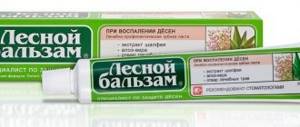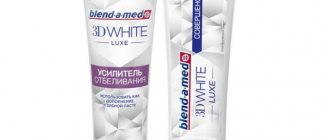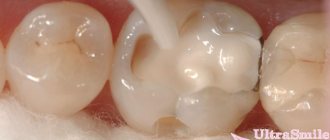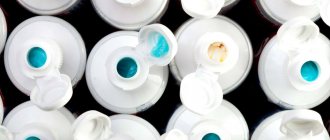There are so many different myths about what the colored stripes on toothpaste tubes mean. Allegedly, they are talking about harmful substances, the permitted frequency of using the paste, and what country or city it was actually made in. The most advanced manufacturers began to produce toothpastes in tubes with a green stripe, supporting the myth of their naturalness. But in fact, such assumptions are wrong, and any dentist can confirm this.
Are all pastes color coded?
We'll tell you a secret - stripes are found not only on toothpaste, but also on any tube that contains creams, gels or any other cosmetic products. And these marking stripes can be of completely different colors (red, green, blue, black) and even shapes (square, rectangular), but are invariably localized on the tail of the tube.
Stripes are found not only on toothpaste, but also on other tubes
Naturally, most consumers have a question - what can color markings mean? Maybe she reveals to us secret information or an important message that will warn us against buying or, conversely, tell us about the miraculous properties of this product? Let's figure it out together.
Features of container production
Before answering the question regarding the true meaning of squares on containers, you need to provide information about the features of their production.
Creating regular tubes looks like this:
- The polymer blank is cut into pieces of a certain length and width;
- The logo, barcode, manufacturer data and other information are applied to the tube;
- Rolling up a segment that takes the shape of a cylinder;
- Sealing the edges of the sample (on one side);
- Filling the container with cream (or other substance);
- Clogging and sealing of the cylinder;
- The date of manufacture and expiration date are printed on the seam. light mark” is also affixed , thanks to which the machine recognizes the exact location where the cut needs to be made.
The specified sequence of actions is applicable to the process of manufacturing plastic products. The mechanism for creating aluminum tubes is somewhat different, but the placement of a color marker also takes place.
The contents of the tube and its color: is there a relationship?
Many Internet users still believe that the colored stripes on toothpaste have something to do with the contents of the tube. For example, this is a designation of the harm or benefit of the ingredients included in the composition. However, this opinion is wrong. You will find out further how things really work out. And now we present to you a selection of the most ridiculous interpretations that can be found on the Internet about what the colored stripe on toothpaste means.
Read the article on the topic: 6 tips to help you choose the perfect toothpaste.
What do the labels actually mean?
You should not trust the above speculations, because the composition is written on the packaging and it is enough to read it, and not come up with special properties for the colored stripe on the tube.
Although the font chosen for printing will not be able to be read by most consumers, it is therefore necessary to take a magnifying glass and a table of harmful components, with the help of which the entire composition of the product is deciphered.
The colored stripes do not contain any secret messages, no matter how much some dreamers might like them to. The colored rectangles on the tubes are just “markings” or “light marks” that the conveyor needs to correctly cut the tube blank.
The conveyor sensor reads the mark on the moving belt of the tube blank and cuts it at this point. Then, the cut piece of foil is twisted, glued, the tube is filled with paste, with the lid and cap at the bottom. Finally, the edge of the tube is wrapped or soldered.
Myth No. 1: a color marker signals the harm or benefit of the composition
- green: this is a natural product that contains environmentally friendly ingredients,
- what does the red stripe on toothpaste mean: such products are full of ingredients and substances that are dangerous to the health of the body and oral cavity,
- blue: the product contains synthetic substances, but they are not dangerous to health or life, because their use in a certain ratio is permitted,
- what does a black stripe on toothpaste mean: such a product is very dangerous, and it may also contain substances that provoke gum inflammation, gingivitis, periodontitis and periodontal disease.
There are myths that the strips symbolize the dangers and benefits of the product
Why do we mark the adhesion site?
Let's say right away that marked squares or rectangles of different colors have nothing to do with the quality characteristics of the toothpaste.
The same marks can be found on creams and other products in tubes or sealed bags. Multi-colored markers serve as technological markings. The products are packaged using robotic equipment. It is labeling that allows you to automate the process and eliminate human participation.
Before filling with toothpaste, a plug with a threaded part and a cap is already soldered into the tube. On the conveyor, the empty blank falls into a special conductor. It is filled with hygiene product and moved to the sealing machine. The position of the tube is not controlled at the previous stages. But we all see that the end seam is always positioned so that the main inscriptions are easily read when the tube lies freely on the table. This is possible due to the fact that before sealing, the robot twists each tube into the desired position. We determine the correct orientation of the computer precisely by the stripes in the end part.
The same marks are used in printing houses for cutting material when forming tubes. The computer reads the information from the color markers and cuts the workpieces in the designated places.
In this case, the horizontal strip is responsible for the correct cutting of the workpiece. Vertical for the correct orientation of the seam on the tube. All information must be quickly read.
Note!
There is a special typographic marking on any package. It performs an auxiliary function and is intended only for the correct orientation of printed information and cutting of blanks.
Myth No. 2: color indicates the ratio of chemicals and natural substances in the composition
There are other ridiculous interpretations of what the colored stripes on toothpastes mean. For example, color can indicate the percentage of chemicals in the product:
- black: the product consists entirely of chemical components, i.e. 100%
- blue: there is a little less chemistry here, about 80%,
- red: semi-natural-semi-chemical composition, i.e. 50/50,
- Green: This is a 100% natural, organic and safe product. It supposedly contains only herbs and oils.
“My grandmother heard from a friend about what the stripes on toothpaste and other products mean. After that, she carefully inspected her bathroom and found, oh my God, a package with a black mark!!! It was panic. It took a long time to prove to my grandmother with the whole family that all this was nonsense and give examples: they took shoe polish - there was a green mark on it, was it natural? But the tube with baby cream turned out to have a black mark! It turns out that they are harming children and not even hiding it? The manufacturer has become insolent! We took condensed milk in soft packaging from the refrigerator, and there was a black mark there. Yes, all packages have these marks. In general, they somehow convinced me that everything was fine and there was no catastrophe...”
Larisa, fragment of a review from correspondence on woman.ru
Myth #3: The color will tell you how often you can apply the paste.
Some “experts” on this issue also claim that stripes on toothpaste tubes indicate the presence or absence of abrasives in it and how long such a product can be used:
- black stripe on a tube of toothpaste: it’s all abrasives that will help effectively whiten enamel, as well as remove and prevent the formation of hard deposits and stone. However, you cannot use this composition for a long time; it is better to use it 1-2 times a week and no longer than a month, otherwise there is a risk of damaging the integrity of the enamel and making it very sensitive. It should also not be used by children
It is a misconception that a paste with black marks will dissolve tartar. - red and blue stripes on toothpaste: some Internet users claim that it contains much less abrasives than black, which is why you can use it more often - 2-3 times a week. However, if there are problems with the gums (for example, inflammation, sensitivity), then it is better to stop using the composition and use other types. For example, the “Forest Balm” series, which helps to cope with the manifestations of the inflammatory process on the mucous membrane.
- green: this is a herbal medicine that will not cause harm to enamel and gums even with daily use. This remedy can be used for long weeks and months on end. By the way, as some particularly “vigilant” Internet users claim, a number of manufacturers use the green label to deceive the buyer and pass off the chemical composition as a natural product.
Do not think that all pastes with green labels consist of 100% natural ingredients
Looking for a truly natural oral care product? Read the article on the topic: TOP 7 natural toothpastes from the ECO series.
Why do we really need stripes?
In fact, everything listed above is truly a myth. Let's think logically: if the strip on a tube of toothpaste actually reported that it was harmful, then who would buy it? And what's the point of putting this on the label of your products? Signaling the dangers of a product by labeling toothpaste with a colored stripe is impractical and unprofitable for any business.
You need to understand that today most oral and body care products contain not only natural ingredients, but also chemical impurities that extend the shelf life, allow the products not to deteriorate ahead of time and safely endure transportation from different countries of the world .
So, what do the colors on toothpaste, specifically the colored stripes on a tube of toothpaste, mean? In fact, these tags are completely harmless; they are intended for organization and convenience of the production process. They are indicated when creating a packaging design and its implementation in production. First, tubes with a logo and descriptive information are made on the conveyor, which are pulled as a continuous ribbon before being separated. Next, robotic equipment evenly cuts the tape into equal parts - this must be done in such a way that the design of each individual package is not compromised. This is where markings come in handy, because... It is along them that the incision is made.
The color marks on the tubes are completely harmless
Modern equipment can only perceive bright and contrasting color markers. So that it can count them, black, red, green and blue are most often used. For example, if the packaging is white, then the most contrasting color will be black.
After the machine cuts the tubes, their edges are processed, glued and soldered (right at the location of the colored strip), and filled with paste.
“In GOST 7983-991 about the conditions for labeling toothpaste, as well as in the ISO 11609-95 standard, there are no requirements regarding what kind of stripes the toothpaste should have on the tube - the color and shape can be any. There is also no information regarding what the colors are supposed to mean. The main thing that the manufacturer needs to comply with according to the standards is to indicate the fluoride content, your address, composition, production date and expiration date, as well as special storage conditions,” says pharmacist E.V. Guseva.
Remember that you need to use common sense when choosing a toothpaste; to do this, just read the composition carefully and do not forget to consult with your dentist about which type of product will bring you the most benefit based on the condition of your oral cavity.
Notice
: Undefined variable: post_id in
/home/c/ch75405/public_html/wp-content/themes/UltraSmile/single-item.php
on line
45 Notice
: Undefined variable: full in
/home/c/ch75405/public_html/wp-content /themes/UltraSmile/single-item.php
on line
46
Rate this article:
( 4 ratings, average: 5.00 out of 5)
prevention
- GOST 7983-99. Toothpastes. General technical conditions. - M.: IPK Publishing House of Standards, 2000.
Consulting specialist
Uspangalieva Nina Borisovna
Doctor rating: 9.5 out of 10 (6) Specialization: Dentist-therapist Experience: 13 years








